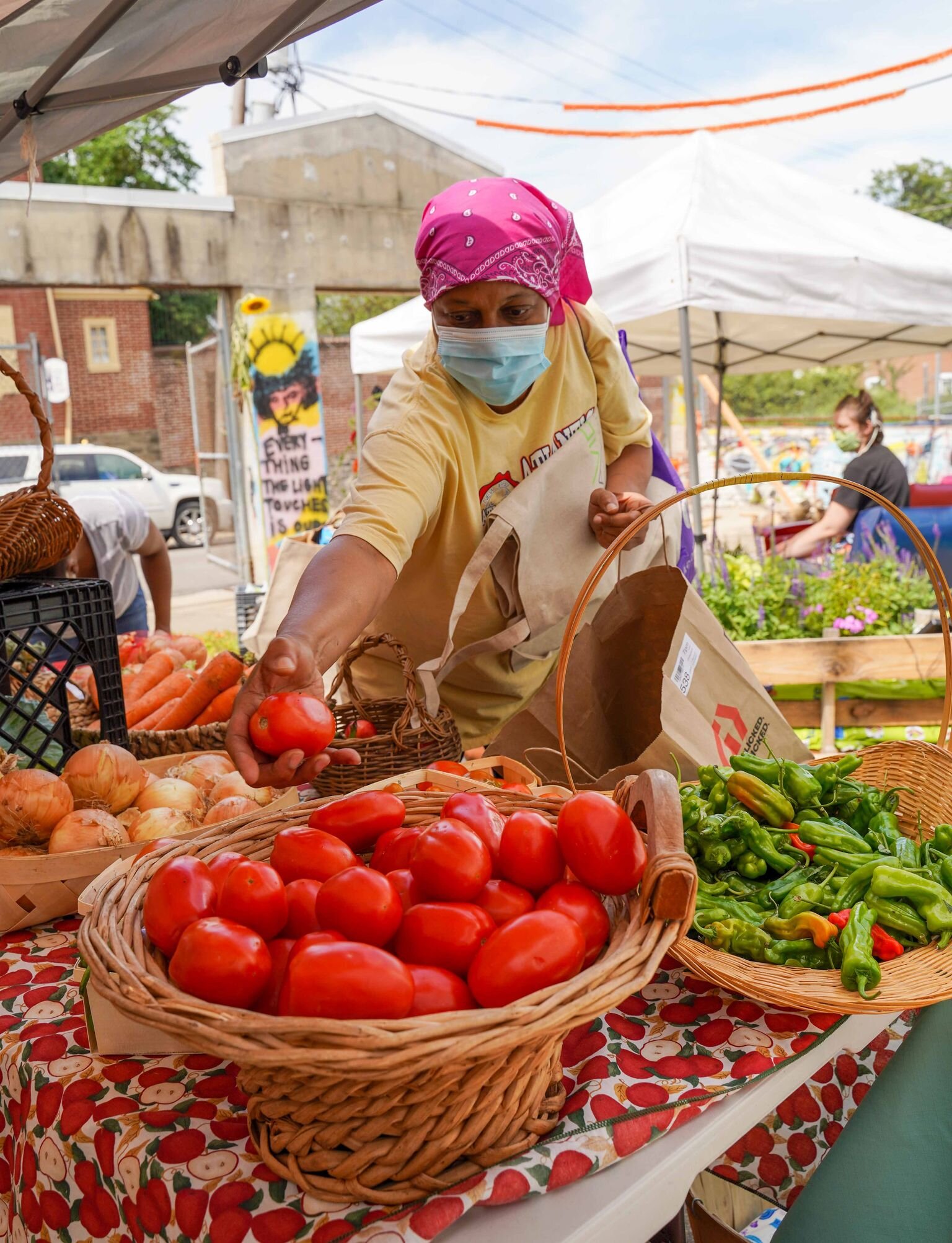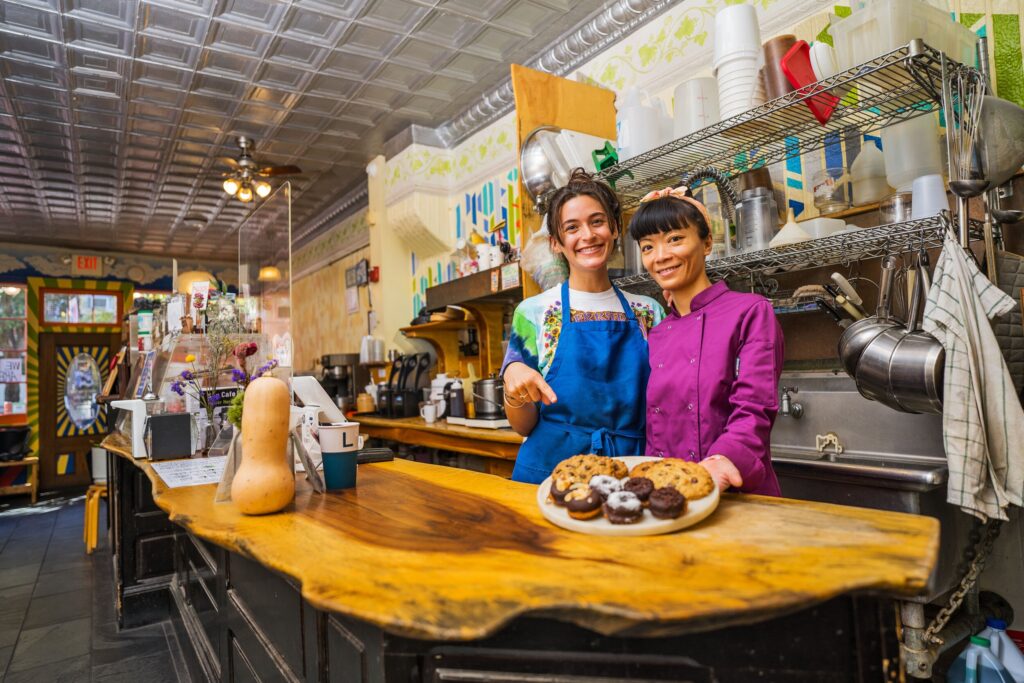With a smattering of bright yellow refrigerators across the city, Michelle Nelson is on a mission to better the lives of food-insecure Philadelphians in light of the pandemic.
“COVID has amplified problems that have always existed and made them more prevalent,” says Nelson, the founder of the Mama-Tee.com Community Fridge Project, which established Philadelphia’s first community fridge, on Seventh Street and Girard Avenue in late July.
The fridges make it easy for neighbors to help neighbors and frames food insecurity as a community problem.
“People say ‘It’s a homeless problem,’ ” Nelson says of food insecurity. “No, it’s not. It’s an everyone problem.”
There are now 11 community fridges across the city. Nelson herself has installed a total of seven in Northern Liberties, Fairmount and West Philly. The other four fridges are not operated by Mama-Tee and are located in West Philly, Germantown and South Philly. The fridges can be found outside breweries, burger shops and restaurants.
COVID-19 and Food Insecurity
The community fridge phenomenon has boomed nationwide, as the need for such services has never been more evident. COVID-19 has worsened food insecurity across the United States.
The term “food insecure” is defined by the USDA as “lack of access, at times, to enough food for an active, healthy life for all household members.” A 2018 study showed that 16.3% of Philadelphia households are food insecure, affecting more than 257,000 people. More than 40% of Philly’s food-insecure homes are more than half a mile away from the nearest food pantry.
Strangely enough, hunger decreased in most of the United States over the last six years, but the number of people who couldn’t afford enough food increased in Philly. Statewide, food insecurity increased by 7% in 2018 but dropped in neighboring New Jersey by 26% and in Delaware by 8%. In 2017, Delaware and New Jersey increased their minimum wage while Pennsylvania did not.
Due to a spike in unemployment levels, experts have estimated the pandemic will only drive these numbers up.
COVID-19 and unemployment were the impetus for the creation of mutual-aid efforts like community fridges. “Like so many other people, I was laid off because of COVID,” explains Syona Arora. “So I had a lot of time on my hands. I was focused on mutual-aid efforts around the city and I saw that my cousin had started a fridge in New York City.” This newfound free time allowed Arora to establish two community fridges in South Philly.
In May 2020, the nonprofit Feeding America made a projection model estimating the number of Americans that would become food insecure because of the pandemic. Their most drastic model showed 14 million additional families, totaling 54 million Americans facing food insecurity. However, that model did not account for the unemployment rate to go beyond 11%, making their projections a conservative estimate.
Not A Charity
As Philadelphia gets its first taste of community fridges, the concept is brand new to many city residents. A community fridge is set up by and for community members to share food with one another. There is no financial exchange or point of sale—the fridge is simply open and available to those who need it.
Sisters Sonia and Sonam Parikh established The People’s Fridge on 52nd Street in honor of their father, who died of COVID-19.
“We wanted a way to memorialize him,” explains Sonam. “It all came together when he died. Literally dozens of people called us who we never met, just being like, ‘Your father used to put food out for us here’ or, ‘He used to buy us groceries sometimes’; ‘He used to leave diapers for single moms.’ It was just humanity at work.”
All of the Philadelphia community refrigerators were established since the COVID-19 pandemic began. Each organizer emphasizes the space their fridges provide for mutual aid.
“This is not an act of charity, this is not, ‘Oh here’s my gross leftover pears.’ It’s simply people feeding people,” says Sonam of The People’s Fridge.
“Mutual aid is when people from a community support the people in their community—I help you, you help me,” Sonam continues. “Anyone who wants food, no matter how much money they make, is welcome to come to the fridge.”
You don’t have to do or give anything to receive mutual aid. “It simply belongs to the people and it’s powered by the people … ,” she says.
Struggles brought on by COVID-19 have forced people to look to one another for help.
Anyone can use a community fridge, says Sonam.
“Single moms who forgot an onion, businessmen who want to bring apples home for their kids,” she explains.
No matter your socioeconomic circumstances, you are welcome to give and/or take whatever you’d like. “So you have everyone from a barista to the single mother who just wants to make ends meet,” says Nelson.
Google Trends shows that in March 2020 interest in the term “mutual aid” began to spike, reaching peak popularity in June.
Community fridges are just one form of mutual aid. Philadelphia has a robust and active network of mutual-aid organizations. Philly We Rise created a directory of mutual-aid efforts that includes links to over 100 different mutual-aid projects, some national, some local. Groups are offering cash, food, technology, housing assistance—even emotional support and advice.
The Do’s and Don’ts of Community Fridges
“If you won’t put it in your own mouth, do not put it in the fridge,” says Sonam.
Each community fridge has their own guidelines specific to their operation. None of the community fridges allow for raw meat, alcohol or expired items. The fridges are typically stocked with healthy items meant to benefit the community. Donating food that is particularly pungent or has the potential to leak should also be avoided.
Fridges are consistently cleaned. With COVID-19 as the motivation for establishing the fridges, hygiene is top of mind.
“The motto of the community fridge is to take what you need and give what you can,” explains Jane Ellis of the Germantown Fridge. “We ask people not to take more than they need.”
Restrictions are in place to avoid cross-contamination and to keep the fridges accessible to as many members of the community as possible. “Our biggest thing is no meat, just to respect dietary restrictions and avoid contamination. Meat is the most likely to go bad,” explains Arora.
Fruits, vegetables and non-perishables like condiments, rice, pasta, peanut butter and pre-packaged goods are welcomed and encouraged. Some refrigerators allow pastries, breads and home-cooked meals, others do not.
Most importantly, everyone is welcome to use the community fridges.
Where are Philly’s Community Fridges?
The People’s Fridge is outside of Sonam’s coffee shop and bakery, Mina’s World, on 52nd Street. It’s a floral refrigerator, provided by Snapdragon Flowers, that was converted by a technician to hold food.
The Germantown Fridge is located outside of the Greene Street Friends School, established by Jane Ellis, a fourth-grade teacher at the school. It’s housed by a shed that was painted by Germantown residents. Inside the colorful shed there is also a pantry filled with non-perishables, personal protective equipment and a myriad of snacks.
Mama-Tee, which operates the lion’s share of Philly’s community fridges, are located outside of Ambassador and Spot Gourmet Burgers, on opposite sides of Girard Avenue; by Triple Bottom Brewing, on Spring Garden Street; outside Franny Lou’s Porch, in Kensington; Castellino’s Italian Market, in Fishtown; Philly’s Fairhill section; and 39th Street in West Philly.
There are two fridges in South Philly run by Arora, under the moniker Philly Community Fridges. One can be found outside of the Bok Building, and the other at Sixth and Titan streets.











